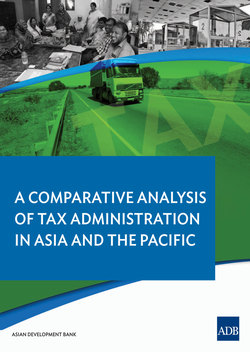A Comparative Analysis on Tax Administration in Asia and the Pacific

Реклама. ООО «ЛитРес», ИНН: 7719571260.
Оглавление
Satoru Araki. A Comparative Analysis on Tax Administration in Asia and the Pacific
A COMPARATIVE ANALYSIS OF TAX ADMINISTRATION IN ASIA AND THE PACIFIC. Satoru Araki and Iris Claus
Contents
Tables and Figures
Abstract
Acknowledgments
Abbreviations
Executive Summary
I. Introduction
II. Tax Revenue Collections
III. Institutional Arrangements for Revenue Bodies
A. Organizational Characteristics of Tax Administrations
B. Relationship with the Ministry of Finance
C. Oversight Board of Tax Administration
D. Extent of Revenue Bodies’ Autonomy
E. Other Nontax Functions of Revenue Bodies
IV. Internal Organization Design of Revenue Bodies
A. Models of Internal Organization Design
B. Large Taxpayer Unit
C. Office Network
V. Human Resources Management
A. Number of Staff Members
B. Relative Staffing Levels of Revenue Bodies
C. Allocation of Staff Resources by Functional Groupings
D. Staff Attrition Rates
E. Aspects of Human Resources Management
VI. Budget and Expenditure
A. Overall Tax Administration Expenditure
B. Measures of Relative Costs of Administration
VII. Taxpayer Identification and Filing
VIII. Electronic Taxpayer Services
A. Information and Communication Technology and Tax Administration
B. In-House Information and Communication Technology Function
C. Electronic Tax Filing Systems
D. Electronic Tax Payment
E. Other Electronic Taxpayer Services
IX. Tax Audits
A. Audits as a Pillar of Tax Administration
B. Performance of Tax Verification Activities
C. Information Gathering and Search Powers
X. Arrears Collection
A. Tax Debt Management
B. Enforcement Powers
XI. Administrative Arrangements for Tax Disputes
A. Benefits of Administrative Review Systems
B. Institutional Frameworks of the Administrative Review System
C. Operational Performance in Administrative Review
D. Direction for Better Dispute Resolution Systems
APPENDIX 1. Aggregate Tables
APPENDIX 2. Tax Administration Bodies Covered in This Report
References
Отрывок из книги
April 2014
The authors thank the Centre for Tax Policy and Administration, Organisation for Economic Co-operation and Development (OECD) for helping in the planning of the ADB tax administration survey; providing comprehensive survey data from a number of countries that are included in the OECD comparative information series, Tax Administration 2013; and reviewing a draft version of the report. ADB also acknowledges cooperation and assistance from tax authorities in Brunei Darussalam; Cambodia; the Kyrgyz Republic; Lao People’s Democratic Republic; the Maldives; Mongolia; Myanmar; Papua New Guinea; the Philippines; Taipei,China; Tajikistan; and Thailand.
.....
Information and communication technology (ICT) is another important aspect for tax administrations. It is a significant component of the overall expenditure budget for several revenue bodies, but ICT costs as a percent of total expenditures are relatively low in some countries (e.g., Indonesia, the Kyrgyz Republic, and Malaysia). ICT offers electronic taxpayer services, which can significantly reduce administration costs and taxpayer compliance costs. Availability and penetration rates of electronic filing systems vary among jurisdictions. In developing countries, while there are challenges to expand the usage of electronic filing, for example, because of the limited availability of internet access for individuals, there probably is scope for expanding electronic filing by companies for corporate income and value-added taxes.
Regarding tax payments, either internet banking or direct debit via bank accounts is available in 16 jurisdictions. Some revenue bodies still offer traditional payment methods such as in-person payment at tax offices, which are costly to provide. A shift to electronic tax payment methods would help reduce tax administration costs and the scope for bribery and corruption, which is substantially higher with in-person payments at tax offices. Moreover, some revenue bodies (12 out of 22) have started to use social media platforms such as Facebook, Twitter, and YouTube to provide information and interact with taxpayers. While the use of social media platforms is still limited, they could become an effective communication tool for tax administrations, and future developments are expected in this area.
.....